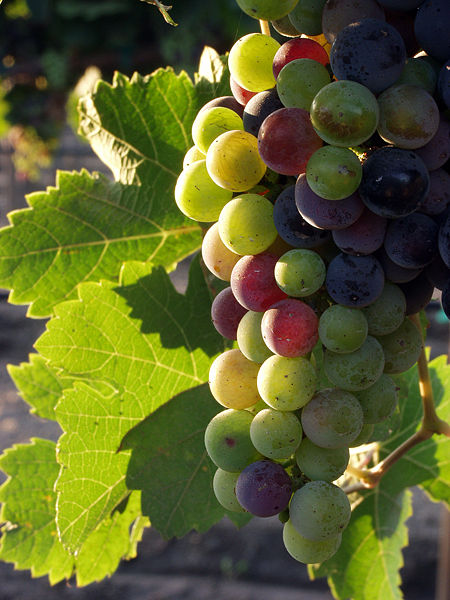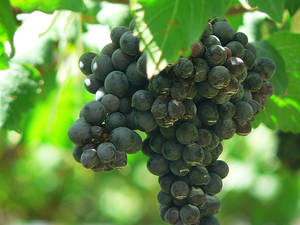When is a grape ready for wine making?
Interview with
Chris - Now here's a question. What makes a grape ideal for turning into wine? Steve Tyerman.
Steve - Well what we've discovered in the berries of grapevines is that, later in development, as they're ripening, they undergo a process of cell death. Now, this hasn't been recognised previously and it occurs fairly late in ripening, but still before harvest. Now, we see this through using dyes that detect living and dead cells. And what was quite extraordinary was the fact that we see big differences between different varieties. So in wine grapes, we see this progressive cell death which gets worse and worse until harvest. So only a small proportion of the actual berry is still living. Whereas in table grape varieties, we don't see that happen at all. In fact, you can go to the supermarket and buy some grapes, the actual berries and do the tests on these and generally, you'll see that they're all still living. So they're nice and crisp and turgid in the mouth, and they taste nice and fresh, whereas a grape berry if you do that, they feel like just a bag of sugar, sugary fluid. And there's no turgidity or crispness about them. It's very likely that they're selected for that very reason.
been recognised previously and it occurs fairly late in ripening, but still before harvest. Now, we see this through using dyes that detect living and dead cells. And what was quite extraordinary was the fact that we see big differences between different varieties. So in wine grapes, we see this progressive cell death which gets worse and worse until harvest. So only a small proportion of the actual berry is still living. Whereas in table grape varieties, we don't see that happen at all. In fact, you can go to the supermarket and buy some grapes, the actual berries and do the tests on these and generally, you'll see that they're all still living. So they're nice and crisp and turgid in the mouth, and they taste nice and fresh, whereas a grape berry if you do that, they feel like just a bag of sugar, sugary fluid. And there's no turgidity or crispness about them. It's very likely that they're selected for that very reason.
Chris - Looking at the picture you've got here of precisely this effect, can you just talk me through what that picture is actually showing?
Steve - Okay. Well what we've got on the screen is a transverse section for berry, stained with a dye that detects living cells and the table grape variety, which is Thompson seedless, shows that most of the cells were living through the berry, whereas the wine grape variety that you're looking at as Chardonnay, it's a popular one variety across the world, and a popular Bordeaux style as well. And you can see that there are just a few cells living around the periphery of the berry and this is associated with the vasculature, but the large juice cells, which make up most of the volume of the berry are actually dead or dying. So their membranes have disintegrated and released the contents of the various compartments in the cell that is mixed and it's very likely that this has actually influenced the biochemistry as well as the general structure, and shape of the berry.
Chris - So, presumably, an experienced wine maker will basically be doing with their tongue what you're clever dye is doing here on the screen?
Steve - Yeah.
Chris - They're be able to tell when a grape has reached that appropriate level of cell death for the flavours to be coming out. So that's an ideal time to make wine?
Steve - Yes, that's probably correct. We're testing that at the moment using berry sensory analysis to see if it correlates with the onset of cell death. But wine makers often describe this engusment of flavour where there's a sudden increase in the varietal flavours that one detects with say, reisling, viognier. And this engusment of flavours sometimes occurs very rapidly. So it could well be associated with the onset of cell death, but we haven't actually proven that yet. We've just shown that this cell death stage occurs late in ripening and before harvest. So it certainly is happening and it is possible that the wine makers and viticulturists are detecting it. But we don't know that for sure yet.
Chris - Could you make that happen at different stages of ripening in a grape, in order to make it juicable, if you like, and therefore, alter subtly the characteristic of the wine you could make?
 Steve - Yeah. But we're interested in it for that reason, but also, there's a correlation between the onset of cell death in the berry and water loss from the berry. So in a warm climate such as we have in Australia, you get a lot of - you can get a lot of water evaporating from a berry- and it's correlated with the onset of this cell death. So the more cell death that occurs in the berry, the more weight loss occurs. And we see this generally across all the wine grape varieties and those that have more cell death tend to be more susceptible to weight loss. In fact, this can be so much so that in the variety Shiraz, they can lose up to 30% of the maximum weight of the berry before harvest, which to the growers is a lot of yield loss. It's not necessarily a bad thing for the wine makers because you get more sugar, if water evaporates from the berry that concentrates the sugar. But we need to understand why that happens in some varieties more than a dozen others because, you know, in a warm or dry climate, it's likely that this will be exacerbated. So, we're interested in them from a climate point of view. But as you say, if we can make this happen earlier or even not allow it to happen, we don't know what would happen if that occurred to a lesser extent in terms of flavour development or to a greater extent, or if it occurred earlier, whether that would turn to be useful or not, I don't know.
Steve - Yeah. But we're interested in it for that reason, but also, there's a correlation between the onset of cell death in the berry and water loss from the berry. So in a warm climate such as we have in Australia, you get a lot of - you can get a lot of water evaporating from a berry- and it's correlated with the onset of this cell death. So the more cell death that occurs in the berry, the more weight loss occurs. And we see this generally across all the wine grape varieties and those that have more cell death tend to be more susceptible to weight loss. In fact, this can be so much so that in the variety Shiraz, they can lose up to 30% of the maximum weight of the berry before harvest, which to the growers is a lot of yield loss. It's not necessarily a bad thing for the wine makers because you get more sugar, if water evaporates from the berry that concentrates the sugar. But we need to understand why that happens in some varieties more than a dozen others because, you know, in a warm or dry climate, it's likely that this will be exacerbated. So, we're interested in them from a climate point of view. But as you say, if we can make this happen earlier or even not allow it to happen, we don't know what would happen if that occurred to a lesser extent in terms of flavour development or to a greater extent, or if it occurred earlier, whether that would turn to be useful or not, I don't know.
Chris - But maybe if you could trigger that by spraying the plant with something so then all the plants, all the grapes in register, all kill themselves internally. So then you minimise the water loss, maximise the flavour, and you know exactly when you want to pick them.
Steve - Well, one of the issues that we have actually is that sugar concentrations in berries has been increasing over the decades and one can claim that this is an impact of climate change. So for example, red grape varieties in Australia have increased when we make wine from them. The alcohol content is increased by about 1% per decade, which you know, has health implications and also flavour implications because it's harder to balance a hot alcoholic wine with other flavours. So, we're actually interested in Australia in reducing the alcohol content. And to reduce the alcohol content, we have to reduce the sugar content in the berry. So this onset of cell death and water loss has a direct impact on the sugar because if water is lost from the berry, the sugar concentration increases. If we can get this process to occur earlier in sugar ripeness, that should result in less water loss at harvest and potentially lower sugar concentrations in the berry.










Comments
Add a comment